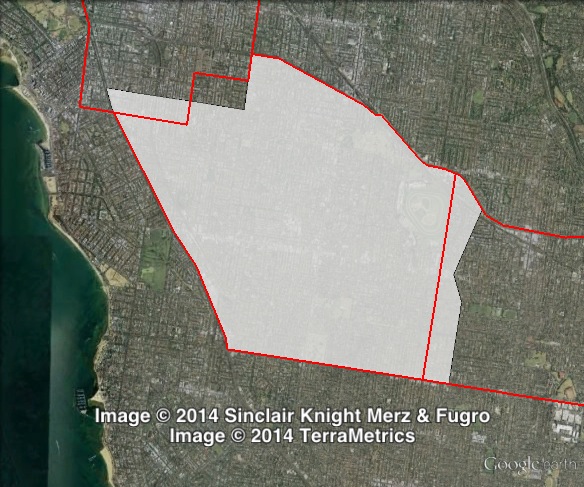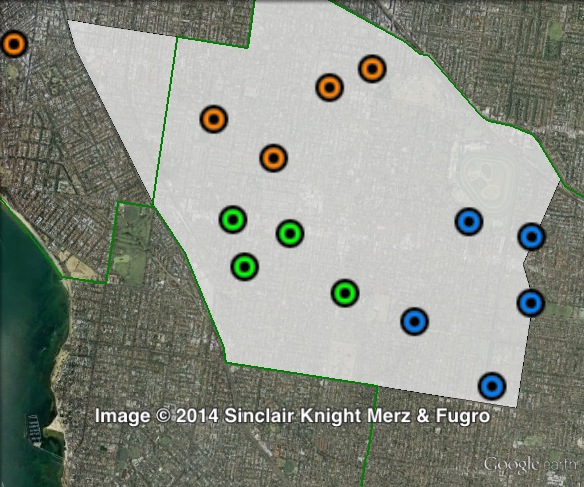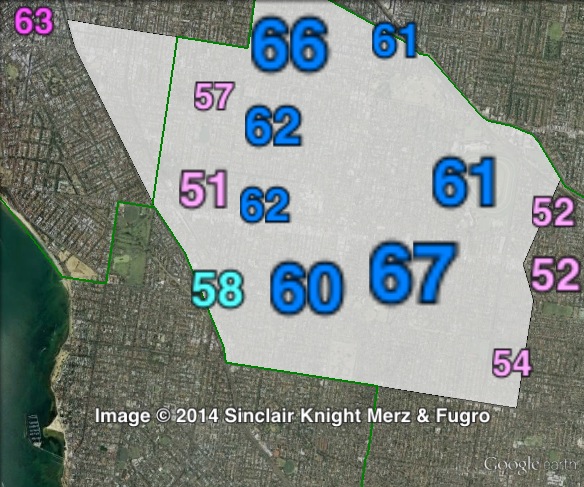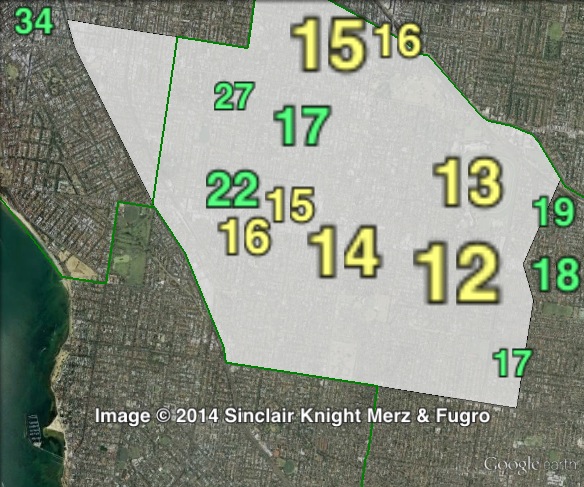LIB 9.8%
Incumbent MP
David Southwick, since 2010.
Geography
Southeastern Melbourne.Caulfield covers the suburbs of Balaclava, Caulfield, Elsternwick, Gardenvale, Glenhuntly and Ripponlea and parts of the suburbs of Ormond, St Kilda and St Kilda East. Caulfield covers northwestern parts of the City of Glen Eira and small parts of the City of Port Phillip to the east of St Kilda.

Redistribution
Caulfield gained the remainder of Glen Huntly from Oakleigh, and underwent some adjustments to its northwestern border with Prahran. These changes reduced the Liberal margin from 11.5% to 9.8%.
History
Caulfield was first created in 1927. In that time it has never been won by the ALP, and has always been won by conservative candidates, except one election when the seat was won by an independent socialist, in 1943.
The seat was first won in 1927 by the Liberal Party’s Frederick Forrest. He was re-elected in 1929, but died in office in October 1930.
The ensuing by-election was won by Harold Luxton. He held the seat for two terms, retiring in 1935. He was replaced in 1935 by Harold Cohen. He had been an MLC representing Melbourne South since 1929, and held Caulfield until 1943.
In 1943, Cohen was defeated by Andrew Hughes, an independent socialist candidate. Hughes only held the seat for one term, losing to the Liberal Party’s Alexander Dennett.
Dennett ran as a candidate for the Electoral Reform party in 1955, and lost his seat to the Liberal Party’s Joseph Rafferty. Rafferty moved to the seat of Caulfield in 1958, which he held until 1967, when he moved again to Glenhuntly, which he held until his retirement in 1979.
In 1958, Caulfield was won by Alexander Fraser. He had previously held the seat of Grant from 1950 until his defeat in 1952, and then Caulfield East from 1955 to 1958. Fraser held the seat until his death in 1965.
The 1965 by-election was won by Ian McLaren. He had previously held the seat of Glen Iris for one term from 1945 to 1947. After one term in Caulfield, he moved to Bennettswood in 1967 and held it until his retirement in 1979.
In 1967, Caulfield was won by Edgar Tanner, who had previously been the Liberal Member for Ripponlea since 1955. He held Caulfield until his retirement in 1976.
Charles Francis won Caulfield in 1976. The next year he was expelled from the Liberal Party after abstaining on a no-confidence motion against the Liberal government, and he lost his seat in 1979 to Ted Turner, son of the former member.
The younger Turner served as a shadow minister in the 1980s and as Government Whip in the first term of the Kennett government, retiring at the 1996 election.
Caulfield was won in 1996 by the Liberal Party’s Helen Shardey. Helen Shardey was re-elected in 1999, 2002 and 2006, and served on the frontbench when the Liberal Party was in opposition.
Shardey retired in 2010, and Caulfield was won by Liberal candidate David Southwick.
Candidates
- John Myers (Independent)
- Tim Baxter (Greens)
- Teresa Horvath (Rise Up Australia)
- Josh Burns (Labor)
- David Southwick (Liberal)
Assessment
Caulfield is a reasonably safe Liberal seat.
2010 election result
| Candidate | Party | Votes | % | Swing | Redist |
| David Southwick | Liberal | 19,018 | 57.75 | +3.77 | 55.33 |
| Heather Abramson | Labor | 7,729 | 23.47 | -5.46 | 25.20 |
| Phillip Walker | Greens | 5,307 | 16.11 | +0.85 | 16.60 |
| Eric Labonne | Family First | 490 | 1.49 | -0.03 | 1.43 |
| Daniel Sapphire | Independent | 227 | 0.69 | +0.69 | 0.58 |
| Peter Brohier | Independent | 163 | 0.49 | +0.49 | 0.41 |
| Democratic Labor | 0.14 | ||||
| Sex Party | 0.11 | ||||
| Other independents | 0.20 |
2010 two-party-preferred result
| Candidate | Party | Votes | % | Swing | Redist |
| David Southwick | Liberal | 20,267 | 61.53 | +3.9 | 59.80 |
| Heather Abramson | Labor | 12,672 | 38.47 | -3.90 | 40.20 |

Booth breakdown
Booths in Caulfield have been divided into three parts: central, north and east.
The Liberal Party won a two-party-preferred majority in all three areas, all with 56-57% of the two-party-preferred vote.
The Greens polled strongly in Caulfield, with a vote ranging from 15% in the east to 20% in the north.
| Voter group | GRN % | LIB 2PP % | Total | % of votes |
| East | 15.07 | 56.52 | 8,321 | 22.07 |
| North | 20.16 | 56.36 | 7,697 | 20.41 |
| Central | 16.77 | 57.23 | 6,631 | 17.59 |
| Other votes | 15.56 | 63.49 | 15,059 | 39.94 |




Heard story that in 2002 Labor candidate was worried he was going to win having no interest in being MP. Would this be a Labor seat on federal figures due to Danby’s appeal to Jewish voters?
Geoff,
Basically yes but its eroding over time, I think personally the Danby effect is now in the range of 2-4% 2PP but in the Caulfield/East St Kilda booths only, the bulk of the ALP’s vote is actually in St Kilda (off Green preferences) and in the 60/70 2pp range and this pretty much holds the seat down for the ALP.
You also need to remember that Caulfield is cut in half federally with Goldstein taking the booths below Glen Huntly road. The swing back to the Liberals in the booths south of Glen Huntly Road (which had been redistributed back into Goldstein) in 2013 was pretty much identical to the swing north of Glen Huntly Road. This suggests the “Danby effect” maybe an assumption rather than a fact.
Caulfield is within the Federal seat of Melbourne Ports (Danby). Jews vote ALP, Lib, Greens etc just like all other voters. The total so called Jewish vote is about 30% in the state electorate of Caulfield and about 10% in the federal electorate of Melbourne Ports. Danby’s support mainly comes more from the traditional red/green vote outside the Jewish bit in Caulfield.
Southwick is a Jew as Danby is.